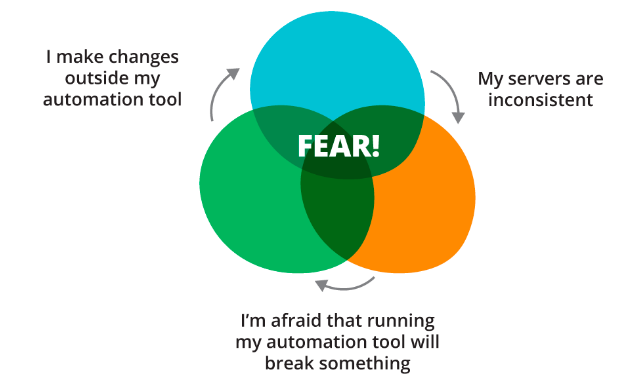Management of an organization in this cloud-era is often a critical aspect and the new generation of technologies seems to promise a transformation in its infrastructure. Any large scale company like Amazon, Netflix, Google or Facebook have sensitive environments and practice no tolerance policy for downtime as their systems handle hundreds of millions of dollars in transactions every day. There’s constant emphasis on consistent, repeatable routines for provisioning and changing systems and their configuration. With such heavy-duty tasks on hand, the advent of modern tooling is required to treat infrastructure as if it were software and a set of data. These organizations pioneer the new practices for their large scale, highly reliable IT infrastructure.
While many are still skeptical about the tools, let’s see how infrastructure as Code(IaC) can provide principles, practices, and patterns for using these technologies effectively.

IaC: What and Why
An approach to automate the infrastructure based on practices adopted from software development, IaC builds an IT setup that lets you manage the technology stack for an application without manual processing and configuring discrete hardware devices and operating systems. It is capable of deploying tools such as version control systems (VCS) and experiment with development practices such as test-driven development (TDD), continuous integration (CI), and continuous delivery (CD) to solve the problem of environment drift in the release pipeline.
Sometimes referred to as programmable or software-defined infrastructure, it uses descriptive language to code more versatile and adaptive provisioning and deployment processes. For instance, Ansible, an IT management and configuration tool can include the capabilities of IaC to install MySQL server, verify it and perform other functions.
As a key DevOps practice, you can move past relying on system administrators and establish servers and applications to be used in conjunction with continuous delivery to establish stable environments rapidly and at scale.
Benefits of Infrastructure as Code
Moving past the drawbacks to manual processes, listed are some reaping benefits of IaC for your company:
Lighting Speed
A single system becomes capable of running multiple structures to architect it in a fashion that aligns with the organization. From pre-configured databases and network infrastructure to storage systems or any other cloud service, IaC allows you to quickly and easily develop, stage, and produce efficient environments. You can standardize the process by simply writing codes and running them.
Super Consistency
Once the operations are running within a standard procedure, the next step is maintenance which gets streamlined with minimum gaps for error. The infrastructure setup reduces the possibility of oversights and decreases the chances of incompatibility issues with the infrastructure. This also helps your applications to run more smoothly and hassle-free.
Minimum Risk
The manual setups are full of dependencies on resources but with the automated process, you are provided with proper documentation for the infrastructure. It safeguards the institutional knowledge from leakage in case any employee leaves the organization.
However, as systems are coded and configured in a certain manner, it can lead to another kind of dependency on one personnel. But IaC allows server configuration that can be documented, logged and tracked later for reference. As the features, additional integrations and edits to the applications are required to be accommodated, it can be easily done without failure.
Higher Efficiency
With the implementation of the IaC, productivity among developers and the team is said to improve drastically as the cloud architectures are deployed at stages where the software development life cycle becomes more efficient. Minimizing human inaccuracies and eliminating the lack of knowledge about what’s installed and how it’s configured, your company can use Continuous Integration and Continuous Deployment techniques with IaC.
Maximum Saving
With everything automated and organized, engineers save up on time and cost which can be wisely invested in performing other manual tasks and higher-value jobs. This also leads to saving up on hiring extra resources for assignments that now IaC handles with coherence. Further, within the IaC itself, the system spins down environments that get redundant and saves on the cloud computing costs.
Best Practices For IaC
Everything Codified
The main element of Infrastructure as Code is explicit coding to configure files in use. More than provisioning, it reduces the misconfiguration in the application with seamless deployment and provides a single source of truth for your infrastructure specifications. You can share codes with the team, test them to ensure accuracy, maintain uniformity and update your infrastructure to slip right into the same flow as IaC.
Documentation to Minimum
Surely documentation shares knowledge and keeps a track but it often becomes stale at a later stage and not every developer invests enough time in reading them. Also, documentation cannot be tested as codes. However, with IaC the code itself represents the updated documentation of the infrastructure.
No additional documentation is required except setup instructions for the employees to get familiar with the infrastructure deployment process. Everything is coded and ideally keeps documentation to a minimum.
Version controlled, Tested and Integrated
IaC allows you to track and give insights on what, who and why anything changed in the process of deployment. Moreover, every action can be tested and repeated at multiple stages that lead to better management of the infrastructure. As mentioned above, all codes are managed, tracked and reconciled, thus the configuration files are version-controlled. They also provide trail codes for the changes and the ability to review the codes before it goes live.
For error-free post-deployment process, testing is the key. From unit to integration test, depending on your needs, you can rigorously apply them to your infrastructure configurations to ensure the elimination of bugs and threats. A sound integration process leads to templating the provision multiple times in different environments such as Dev, Test, and QA. This makes for a successful production.
Code Modularisation
A known trend in the industry, microservices architecture can be applied to IaC where the modular units of code can be independently deployed. By breaking the infrastructure into small modules or stacks, you can grasp greater accountability over who has access to which parts of your infrastructure code.
Modularisation limits access to junior engineers who might not be ready to handle any higher-level tasks in the process. It naturally limits the changes made to the configuration. Ensuring infrastructure consistency, a template can be created for each microservice that are connected through HTTP or messaging interfaces.
Immutable infrastructure
IT infrastructure components are required to be replaced for each deployment. The process of terminating the stack can be made consistent with immutable infrastructure to avoid configuration drift and to restrict the impact of undocumented changes in the stack. While it may not be an ideal solution and is debatable, it can be put to test whenever possible.

This fear spiral is the vicious loop for developers and infrastructure teams can break it in order to automate successfully. This automation fear spiral is lead by Configuration drift and lack of confidence in the automation because the servers may not be consistent. What can help here is starting small and simple. Like all other fears, this one also needs to be faced but with a set of servers and tweaking the configuration definitions. Gather the courage and pick up a server and repeat the process until all of them are continuously updated.
The bottom Line
Infrastructure as Code is shifting organizational apparatuses to accelerate processes, document infrastructure and maintains consistency in the policies to minimize error and maximize money in no time. Pacing with the changes and moving along the next generation of technology, IaC can make you catch the flight to success and advancement.
Have questions? Contact our experts for assistance at [email protected].
Subscribe
Related Blogs
Trek n Tech Annual Retreat 2025: A 7-Day Workcation of OSL

OSL family came together for the Trek n Tech Annual Retreat 2025, a 7-day workcation set amidst the serene beauty of…
Exploring Drupal's Single Directory Components: A Game-Changer for Developers

Web development thrives on efficiency and organisation, and Drupal, our favourite CMS, is here to amp that up with its…
7 Quick Steps to Create API Documentation Using Postman

If you work with API , you are likely already familiar with Postman, the beloved REST Client trusted by countless…




